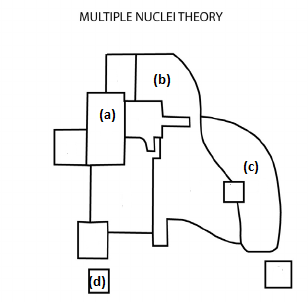 Multiple Choice Questions
Multiple Choice QuestionsWhich one ofthe following principles denote K-4 of Christaller's model of central places?
Market
Administrative
Trnasport
Economic
C.
Trnasport
The different layouts predicted by Christaller have K-values which show how much the sphere of influence of the central places take in- the central place itself counts as I and each portion of a satellite counts as its portion :
1.Marketing Principle (K=3)
2.Transport/Traffic Principle (K=4)
3.Administrative Principle (K=7)
Which one of the following does not belong to the Exploitative Model of Urban Structure propounded by William Bunge?
City of superfluity
City of Death
Central Business District
City od Need
|
LIST I (Term) |
LIST II (Definition) |
| (a) Central City | (1) Continuous built up landscape with high density of buildings with no reference political boundary. |
| (b) Network City | (2) Areas outside city urban characteristics . |
| (c) Urban Influence Zone | (3) Urban area contained within the official boundaries of the main city around which suburb develops. |
| (d) Urbanized Area | (4) Two or more independent but complementary cities having high speed transport corridors. |
a-1 , b-2 , c-4 , d-3
a-3 , b-4 , c-2 , d-1
a-2 , b-4 , c-3 , d-1
a-4 , b-2 , c-1 , d-3
Locate the following places in Multiple Nulcei thoery of urban structure in the figure and match it with the list given below :

LIST :
a-2 , b-3 , c-1 , d-4
a-1 , b-2 , c-3 , d-4
a-1 , b-3 , c-2 , d-4
a-3 , b-4 , c-1 , d-2
Which one of the following does not have role in push factors that seem to be operative in rural India ?
Rapid increase in the population growth
High pressure of population on arable land
Low per capita income and glaring disparity between levels of income of urban and rural areas.
Slow but consistent increase in amenities in rural areas and increase in per capita income.
|
LIST I (Number of likely settlements of different orders) |
LIST II (K Values) |
| (a) 8 , 32 , 128 | (1) K7 |
| (b) 4 , 13 , 40 | (2) K13 |
| (c) 3 , 20 , 141 | (3) K3 |
| (d) 2 , 27 , 351 | (4) K4 |
a-4 , b-3 , c-2 , d-1
a-4 , b-2 , c-3 , d-1
a-1 , b-3 , c-2 , d-4
a-4 , b-3 , c-1 , d-2
ASSERTION (A) : Metros are emerging as efficient , viable and alternate means of transportation in metropolitan cities in our country.
REASON (R) : Old and unplanned cities with rapidly growing populaltion are burdened with muti-mode of transportation of India.
Both (A) and (R) are true and (R) is the correct explanantion of (A).
Both (A) and (R) are true but (R) is not the correct explanantion of (A).
(A) is true , but (R) is false.
(A) is false , but (R) is true.
ASSERTION (A) : Urban agglomeration and metropolitan cities are grwoing rapidly in India.
REASON (R) : Satellite towns are not sufficiently and significantly developed to release the pressure of urban population.
(A) is true , but (R) is false.
(A) is false , but (R) is true.
Both (A) and (R) are true , and (R) is the correct explanation of (A).
Both (A) and (R) are true , but (R) is not the correct explanation of (A).
Which one of the following letters represent the total number of settlements of a certain ordeer served by a central place of the next higher order ?
K
J
L
F
Which are the three basic aspects for spatial interaction as described in Edward Ullman's model ?
Human behaviour , Transferability , Convenience.
Surplus-deficit relationship , Community specific relationship , Complementarity
Transferability , Complementarity , Intervening opportunity
Residential neighbourhood , Convenience , Complementary
